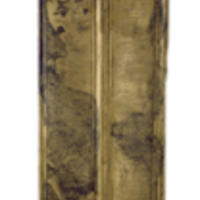European Celtic Art in Context: Exploring Celtic art and its eastern links
The ‘European Celtic Art in Context: Exploring Celtic art and its eastern links’ project, funded by the Leverhulme Trust, was based at the Institute of Archaeology, Oxford from 2015–2018.
Description
Around 500 BC, two great traditions of artistic representation arose in Europe. From the Aegean world sprang a new kind of realism in painting and sculpture, which ultimately grew into the familiar art of Imperial Rome. At almost the same time, to the north of the Alps, the more ambiguous traditions of Celtic art made their first appearance dominated by complex sinuous ornaments composed of spirals, s-forms, and animals forms, often intentionally abstract.
If changes in artistic preference can be seen as a proxy for broader changes in society, in philosophy, cosmology, and self-perception, then in the Classical world this period marks the beginning of a gradual purge of the spiritual or human influences on the material world, and the emergence of the notion of a mechanistic universe. Celtic art, by contrast, represents the material reiteration of an animistic social world in which the boundaries between humans, non-humans, and things are often blurred. Taking a broader view, it is interesting that both of these art forms have a wider continental context, within two great streams of interaction. Celtic art can be seen as the western-most expression of shape-shifting traditions of art found right across the grasslands and deserts of Eurasia, from the Danube to the borders of China. Greek and Roman art, by contrast, are integrated into network of urban interactions stretching east into Central Asia, India, and beyond.
In this project we aimed to characterize and contextualize Celtic art across Europe, but also look seriously at the nature of these eastern connections for the first time. We explored questions at various scales, engaging simultaneously with broad theoretical debates about the nature of art, and detailed regional variations of representational forms across Europe, using both to explore how specific cultural forms were constituted.
At the methodological heart of this project was the construction of a database of material from Europe, collating information on form, motif and archaeological context, which formed the basis with which we set out to place Celtic art in context. We situated this dramatic and influential mode in artistic representation within its specific context, exploring the social arenas in which it was used, relating its distribution to contemporary demography and settlement dynamics, and examining the kinds of places in which it was finally deposited. We attempted to understand how European developments may be related as a sub-set of wider Eurasian styles, in the context and character of ornament, if not its specific content. The connections across ancient Eurasia were vast and durable, and, while they remain poorly understood, they clearly stand in contrast to the emerging urban worlds of the South. The project crossed international and disciplinary boundaries, combining approaches from archaeology, anthropology, and art history to present a new look at this old problem.
During this project, we contributed data to the ‘Art of the Celt’s’ exhibition at the British Museum and published an edited volume and other papers. These are listed below, along with exports from the database.

The Iron Age Wittenham Sword found in the River Thames near Little Wittenham, Oxfordshire. © Ashmolean Museum, University of Oxford

Iron Age cast bronze terret with red and blue glass inlay from Suffolk. © Ashmolean Museum, University of Oxford
Project Members
Prof Chris Gosden - Principal Investigator
https://www.arch.ox.ac.uk/people/professor-chris-gosden
Dr JD Hill (British Museum) – Investigator
https://britishmuseum.academia.edu/JDHill
Dr Jody Joy (Cambridge) – Investigator
http://www.arch.cam.ac.uk/directory/jpj32
Dr Ian Leins (British Museum) – Investigator
https://english-heritage.academia.edu/IanLeins
Dr Courtney Nimura – Researcher; European Celtic art
https://www.arch.ox.ac.uk/people/nimura-courtney
Dr Peter Hommel – Researcher; Eastern art
https://www.arch.ox.ac.uk/people/hommel-peter
Dr Helen Chittock – Researcher (2017); European Celtic art
https://www.aocarchaeology.com/our-staff/our-team/helen-chittock
Outputs
Gosden, C. & Nimura, C. forthcoming. Iron Age Art in Europe.
Nimura, C., Chittock, H., Hommel, P. & Gosden, C. (eds). 2019. Art in the Eurasian Iron Age: Context, connections and scale. Oxford: Oxbow. ISBN: 9781789253948 [https://www.oxbowbooks.com/dbbc/art-in-the-eurasian-iron-age.html]
Gosden, C., Chittock, H., Nimura, C. & Hommel, P. 2019. Context, connections and scale: An introduction. In C. Nimura, H. Chittock, P. Hommel & C. Gosden (eds), Art in the Eurasian Iron Age: Context, connections and scale, 1–8. Oxford: Oxbow
Gosden, C. 2019. Art, ambiguity and transformation. In C. Nimura, H. Chittock, P. Hommel & C. Gosden (eds), Art in the Eurasian Iron Age: Context, connections and scale, 9–22. Oxford: Oxbow
Nimura, C., Chittock, H., Hommel, P. & Gosden, C. 2019. Collecting Iron Age art. In C. Nimura, H. Chittock, P. Hommel & C. Gosden (eds), Art in the Eurasian Iron Age: Context, connections and scale, 23–36. Oxford: Oxbow
O’Sullivan, R. & Hommel, P. 2019. Fantastic beasts and where to find them: Composite animals in the context of Eurasian Early Iron Age art. In C. Nimura, H. Chittock, P. Hommel & C. Gosden (eds), Art in the Eurasian Iron Age: Context, connections and scale, 53–70. Oxford: Oxbow
Chittock, H. 2019. Bodies and objects in Iron Age Europe and beyond: An integrated approach to anthropomorphic imagery. In C. Nimura, H. Chittock, P. Hommel & C. Gosden (eds), Art in the Eurasian Iron Age: Context, connections and scale, 71–94. Oxford: Oxbow
Gosden, C., Hommel, P. & Nimura, C. 2018. Making mounds: Monuments in Eurasian prehistory. In T. Romankiewicz, M. Fernández Götz, G. Lock & O. Büchsenschütz (eds), Enclosing Space, Opening New Ground: Iron Age studies from Scotland to Mainland Europe, 141–52. Edinburgh: Edinburgh University Press.
Gosden, C., Hommel, P. & Nimura, C. 2016. European Celtic art and its eastern connections. Antiquity Project Gallery349(February 2016). http://antiquity.ac.uk/projgall/gosden349
Old website: https://ecaic.wordpress.com
Mapped data: http://celtic.arch.ox.ac.uk
Zipped database (15.5MB):



